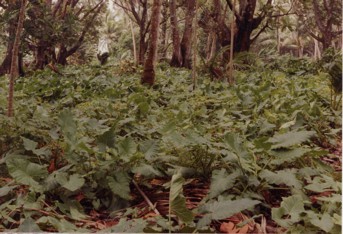

|

|
The Environment of Mile Atoll A Photo Essay by Dirk HR Spennemann |
 Germinating washed-up coconuts among Vigna marina creepers on the lagoonal shore of Mile Island (looking south from a point near the northern tip) |
 A dryland taro patch under beadfruit on Mile Island. |
 Swamp taro on Mile Island. |
 Thicket of Tacca leontopetaloides (mõkmõk) growing on Lukunor Island, Mile Atoll |
[Environment] [Atolls of the Marshall Islands]Bibliographic citation for this documentSpennemann, Dirk H.R. (2002). The Environment of Mile Atoll--A Photo Essay. URL: http:/marshall.csu.edu.au/Marshalls/html/Environment/MileIslandsEnvironment.htmlCONTACT: Dirk H.R. Spennemann, Institute of Land, Water and Society, Charles Sturt University, P.O.Box 789, Albury NSW 2640, Australia. e-mail: dspennemann@csu.edu.au |
| select from the following... | ||||||
|
|
||||||
|
Digital Micronesia-An
Electronic
Library & Archive
is provided free of charge
as an advertising-free
information service
for the world community. It is being maintained by Dirk
HR Spennemann, Associate
Professor in Cultural
Heritage Management,Institute of Land, Water and Society and
School
of Environmental & Information Sciences, Charles
Sturt University,
Albury, Australia. The server
space and technical support are provided by Charles
Sturt University as part of its commitment
to regional engagement. Environmental
SciencesInformation
Sciences
|
||||||